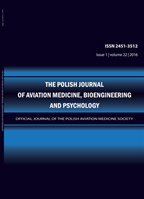2020, Volume 26, Issue 4
EFFECT OF INFLAMMATORY FACTORS IN THE PATHOGENESIS OF CHRONIC RHINOSINUSITIS
ANDRZEJ WOJDAS1
-------------------------------------------------------------------------------------------------
1Department of Otolaryngology, Military Institute of Aviation Medicine
Autor korenspondencyjny: ANDRZEJ WOJDAS; Department of Otolaryngology, Military Institute of Aviation Medicine; email: awojdas@wiml.waw.pl
Full text
Streszczenie
Abstract: Both immune mechanisms, involved in inflammatory processes induced by viral and bacterial pathogens or allergy-inducing agents, and non-immune mechanisms play a direct role in the pathogenesis of chronic rhinosinusitis (CRS).
Contrary to popular belief, bacterial infection plays a much smaller role. As a rule, this is a secondary process – following the development of inflammatory processes in the mucosa of the paranasal sinuses, its defense mechanisms are disrupted, which promotes the development of infection. Bacterial infection of the paranasal sinuses is associated with the formation of a biofilm responsible for the persistence of rhinosinusitis, or bacterial endotoxins acting as superantigens cause the persistence of the inflammatory process.
The main role in the inflammatory process is played by CD4+ and CD8+ T lymphocytes, as the centers regulating cytotoxic and humoral immune responses. They act in various ways, mainly cytotoxic, and as such can interact with virtually all nucleated host cells showing expression of antigens of endogenous origin and through cytokines, mainly pro-inflammatory cytokines, and they increase migration of inflammatory cells into the mucosa of the nasal cavity and paranasal sinuses. The paper discusses in detail the interaction of immunocompetent cells and their impact on chronic inflammatory processes in the mucosa of paranasal sinuses.
Atopy is another factor contributing to the CRS, increasing the action of pro-inflammatory cytokines and promoting processes that lead to obstruction of the ostiomeatal complex.
The complexity of the clinical picture of the CRS in relation to ongoing research on pathogenesis indicates that it is still not possible to strictly define the phenotypes of the disease.
Słowa kluczowe
chronic rhinosinusitis, pathogenesis, CD4+ T lymphocytes, CD8+ T lymphocyte, cytokines, biofilm, atopy
